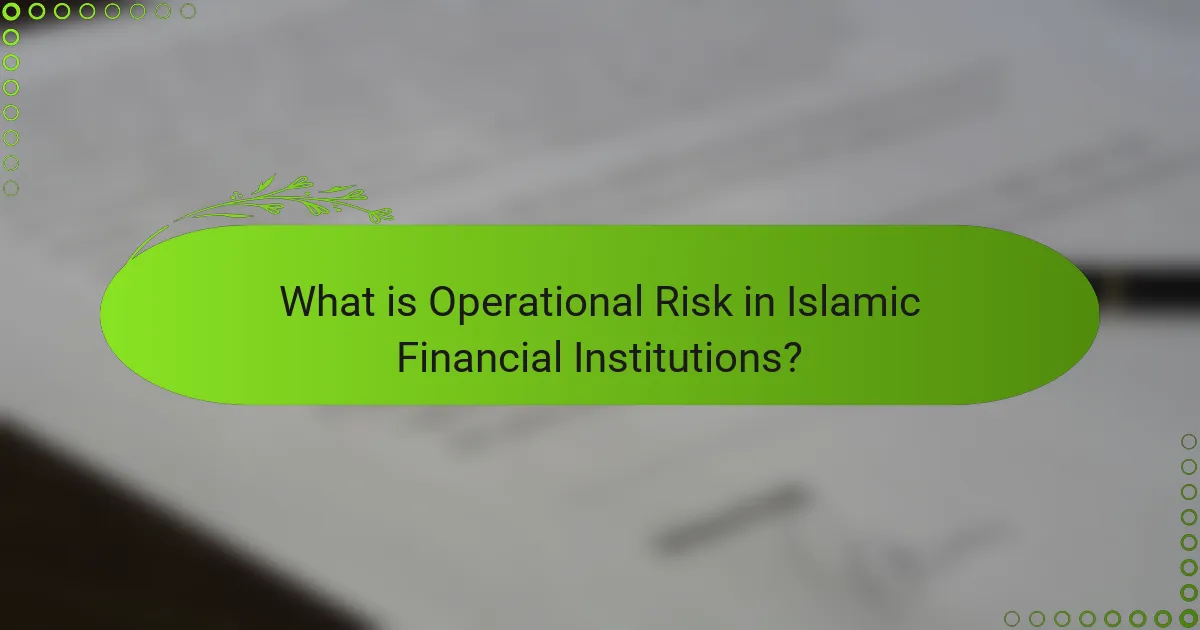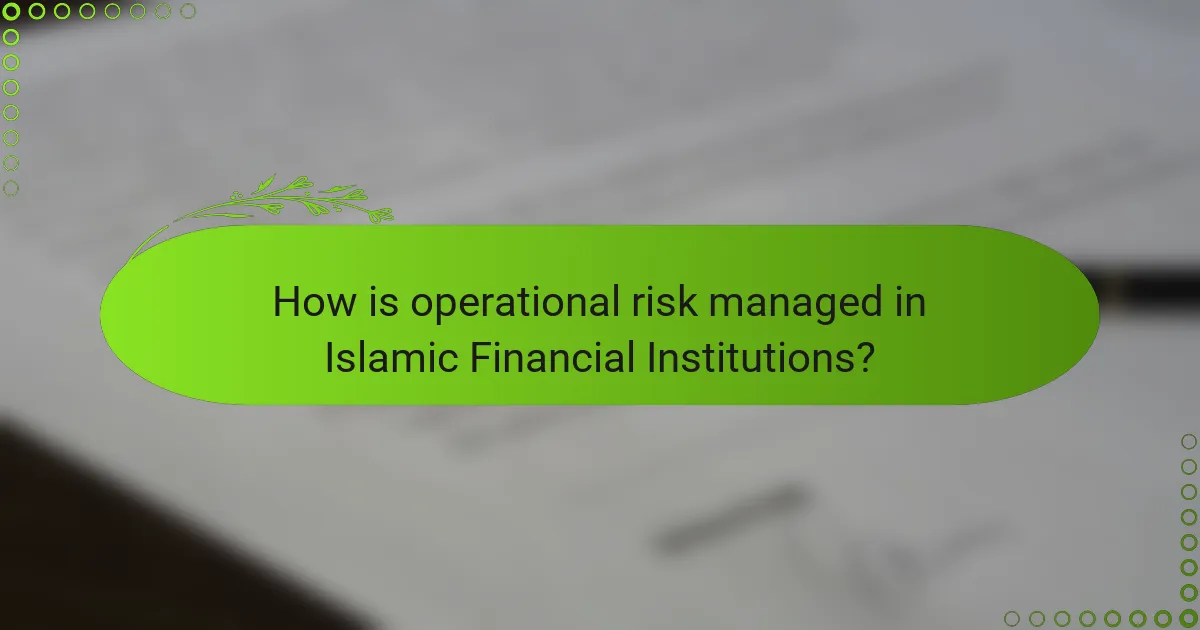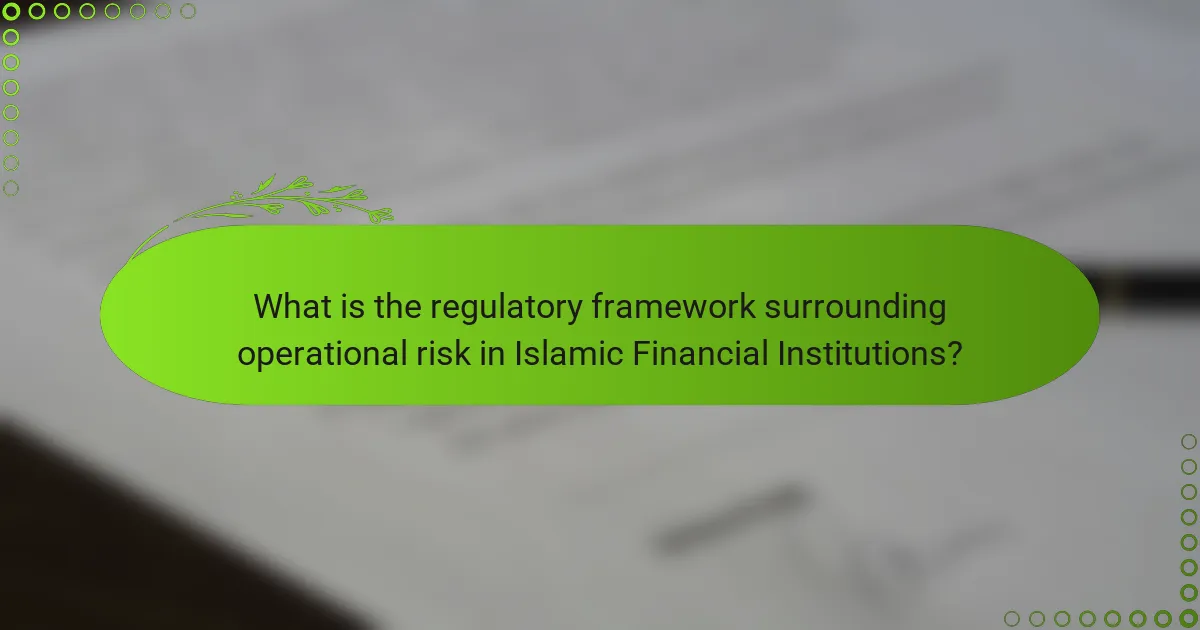
What is Operational Risk in Islamic Financial Institutions?
Operational risk in Islamic financial institutions refers to the potential for loss resulting from inadequate or failed internal processes, people, systems, or external events. This type of risk is particularly significant due to the unique operational frameworks and Sharia-compliant practices of these institutions. Factors contributing to operational risk include compliance failures, fraud, and technology failures. The distinct nature of Islamic finance, which prohibits certain activities, adds complexity to risk management. Effective management techniques involve robust internal controls and adherence to Sharia principles. Regulatory frameworks also play a crucial role in mitigating operational risk by establishing guidelines for risk assessment and management.
How is operational risk defined in the context of Islamic finance?
Operational risk in the context of Islamic finance is defined as the risk of loss resulting from inadequate or failed internal processes, people, and systems, or from external events. This definition encompasses various factors that can disrupt operations within Islamic financial institutions. In Islamic finance, operational risk also includes risks arising from non-compliance with Sharia principles. For instance, transactions that do not adhere to Islamic law can lead to financial losses and reputational damage. Additionally, the unique structures of Islamic financial products can introduce specific operational challenges. These challenges necessitate robust risk management frameworks to ensure compliance and operational efficiency.
What are the key characteristics of operational risk in Islamic financial institutions?
Operational risk in Islamic financial institutions is characterized by the unique principles of Sharia compliance. This includes risks arising from non-compliance with Islamic law. Additionally, operational risk encompasses risks related to inadequate internal processes and systems. Human error and fraud are significant contributors to operational risk in these institutions. Furthermore, reliance on technology introduces cyber risks. The complexity of Islamic financial products adds to the operational risk landscape. Regulatory challenges also play a role in operational risk management. Lastly, the need for specialized knowledge in Islamic finance is crucial to mitigate these risks effectively.
How does operational risk differ from other types of financial risks?
Operational risk differs from other types of financial risks in that it arises from internal processes, people, and systems rather than external market factors. It encompasses risks such as fraud, system failures, and human error, which are distinct from credit risk and market risk that relate to financial transactions and market movements. Operational risk is typically less quantifiable and harder to predict than these other risks. According to the Basel Committee on Banking Supervision, operational risk can account for significant losses, emphasizing its importance in risk management frameworks.
What are the common sources of operational risk in Islamic financial institutions?
Common sources of operational risk in Islamic financial institutions include inadequate internal processes, human errors, and system failures. These institutions often face risks related to Shariah compliance, which can complicate operational procedures. Additionally, external factors like fraud and regulatory changes contribute to operational risk. Data breaches and technology failures are also significant concerns in the digital banking environment. The unique nature of Islamic finance, which prohibits certain transactions, adds complexity to risk management. According to the Islamic Financial Services Board, operational risk remains a critical challenge for these institutions.
What internal factors contribute to operational risk?
Internal factors that contribute to operational risk include inadequate internal controls, poor organizational culture, and insufficient employee training. Inadequate internal controls can lead to errors and fraud. Poor organizational culture may result in a lack of accountability and transparency. Insufficient employee training can cause mistakes in processes and procedures. Additionally, management failures and ineffective communication can exacerbate operational risk. Research by the Basel Committee on Banking Supervision highlights that these factors significantly increase the likelihood of operational failures in financial institutions.
What external factors can influence operational risk in these institutions?
External factors that can influence operational risk in Islamic financial institutions include regulatory changes, economic conditions, technological advancements, and geopolitical events. Regulatory changes can impose new compliance requirements, increasing operational burdens. Economic conditions, such as inflation or recession, can affect financial stability and operational efficiency. Technological advancements can introduce new risks, such as cybersecurity threats. Geopolitical events, including conflicts or trade disputes, can disrupt operations and impact risk management strategies. These factors collectively shape the operational risk landscape for these institutions.

How is operational risk managed in Islamic Financial Institutions?
Operational risk in Islamic Financial Institutions is managed through a combination of risk assessment, internal controls, and compliance with Shariah principles. These institutions conduct regular risk assessments to identify potential operational risks. They implement robust internal control systems to mitigate identified risks. Training programs for staff ensure adherence to operational procedures. Furthermore, Islamic Financial Institutions engage in continuous monitoring of operational processes. They also establish a risk management framework aligned with Shariah compliance. This framework includes guidelines for risk reporting and governance structures. The effectiveness of these measures is supported by regulatory requirements from bodies such as the Islamic Financial Services Board (IFSB).
What management techniques are employed to mitigate operational risk?
Management techniques employed to mitigate operational risk include risk assessment, internal controls, and employee training. Risk assessment identifies potential operational risks through systematic evaluation. Internal controls are implemented to prevent errors and fraud, ensuring compliance with regulations. Employee training enhances awareness of operational risks and promotes adherence to procedures. Regular audits and monitoring are conducted to evaluate the effectiveness of these controls. Additionally, contingency planning prepares institutions for unexpected disruptions. These techniques collectively contribute to a robust operational risk management framework in Islamic financial institutions.
How do risk assessment and monitoring play a role in operational risk management?
Risk assessment and monitoring are essential components of operational risk management. They help identify potential risks that could impact an organization’s operations. Risk assessment involves evaluating the likelihood and impact of identified risks. This process allows organizations to prioritize risks based on their severity. Monitoring, on the other hand, involves tracking identified risks over time. It ensures that risk levels are managed effectively and that new risks are identified promptly. According to the Basel Committee on Banking Supervision, effective risk monitoring can significantly reduce operational losses. This highlights the importance of these practices in maintaining operational resilience.
What are the best practices for implementing risk management frameworks?
Best practices for implementing risk management frameworks include establishing a clear risk management policy. This policy should define the organization’s risk appetite and objectives. Regular risk assessments must be conducted to identify and evaluate potential risks. Engaging stakeholders is crucial for effective communication and collaboration. Training staff on risk management procedures enhances awareness and compliance. Integrating risk management into the organization’s culture fosters proactive risk identification. Continuous monitoring and review of the framework ensure its effectiveness and relevance. Finally, leveraging technology can streamline risk management processes and improve data analysis.
What role does technology play in managing operational risk?
Technology plays a crucial role in managing operational risk by enhancing data analysis and decision-making processes. It facilitates real-time monitoring of operational activities. This allows organizations to identify potential risks promptly. Automation tools reduce human error in operational processes. Advanced analytics can predict risk patterns based on historical data. Furthermore, technology enables robust reporting systems for compliance and risk assessment. According to a report by the Basel Committee on Banking Supervision, effective use of technology can lead to improved risk management frameworks. This demonstrates that integrating technology is essential for mitigating operational risks in financial institutions.
How can Islamic financial institutions leverage technology for better risk management?
Islamic financial institutions can leverage technology for better risk management by implementing advanced data analytics and artificial intelligence. These technologies enable real-time monitoring of financial transactions and risk exposure. Enhanced predictive analytics can identify potential risks before they materialize. Blockchain technology can improve transparency and traceability in transactions. This reduces the likelihood of fraud and operational errors. Moreover, regulatory technology (RegTech) solutions help institutions comply with Shariah law and regulatory requirements efficiently. A study by McKinsey & Company highlights that digital tools can reduce operational risk by up to 30%. By integrating these technologies, Islamic financial institutions can enhance their risk management frameworks significantly.
What are the challenges of integrating technology in operational risk management?
The challenges of integrating technology in operational risk management include data security concerns, system compatibility issues, and the need for skilled personnel. Data security is critical, as sensitive information may be vulnerable to cyber threats. System compatibility poses difficulties when new technologies do not align with existing infrastructure. Additionally, there is often a shortage of skilled personnel capable of managing advanced technological systems. These challenges can hinder effective operational risk management in Islamic financial institutions.

What is the regulatory framework surrounding operational risk in Islamic Financial Institutions?
The regulatory framework surrounding operational risk in Islamic Financial Institutions includes guidelines from various authorities. The Basel Committee on Banking Supervision provides a foundational framework. This framework emphasizes risk management practices specific to Islamic finance. Additionally, the Accounting and Auditing Organization for Islamic Financial Institutions (AAOIFI) issues standards relevant to operational risk. National regulatory bodies also adapt these guidelines to local contexts. For example, the Central Bank of Malaysia has specific regulations for Islamic banks. These regulations focus on governance, risk management, and compliance. They aim to ensure that operational risks are effectively managed within the unique context of Islamic finance.
What regulations govern operational risk management in Islamic finance?
Operational risk management in Islamic finance is governed by various regulations and frameworks. These include the Basel Accords, specifically Basel II and Basel III, which provide guidelines on risk management standards. The Accounting and Auditing Organization for Islamic Financial Institutions (AAOIFI) also issues standards relevant to operational risk. Additionally, the Central Bank of the respective Islamic finance jurisdiction may have specific regulations. These regulations ensure that Islamic financial institutions manage operational risks effectively while adhering to Shariah compliance. The integration of these regulations helps maintain financial stability and protect stakeholders in the Islamic finance sector.
How do these regulations differ from conventional financial regulations?
Islamic financial regulations differ from conventional financial regulations primarily due to their adherence to Sharia law. Conventional regulations focus on profit maximization and risk management without religious considerations. In contrast, Islamic regulations prohibit interest (riba) and promote profit-sharing arrangements. This creates a unique framework for risk assessment and management. Additionally, Islamic finance emphasizes ethical investments and social responsibility, which are not typically mandated in conventional systems. The principles of transparency and fairness are also more pronounced in Islamic finance. This regulatory approach aims to ensure economic justice and equitable distribution of wealth.
What are the compliance requirements for Islamic financial institutions?
Islamic financial institutions must comply with Sharia law and regulatory frameworks. Compliance involves adhering to principles such as the prohibition of riba (interest), gharar (excessive uncertainty), and haram (forbidden) activities. Institutions must establish a Sharia board to oversee compliance with these principles. They must also ensure transparency in financial transactions and risk management practices. Regulatory requirements often include capital adequacy, liquidity ratios, and risk assessment protocols. Many jurisdictions require adherence to guidelines set by bodies like the Accounting and Auditing Organization for Islamic Financial Institutions (AAOIFI) and the Islamic Financial Services Board (IFSB). Compliance with these requirements is essential for maintaining the integrity and trust in Islamic finance.
How do international standards influence local regulatory practices?
International standards significantly influence local regulatory practices by providing a framework for consistency and compliance. These standards help ensure that local regulations align with global best practices. For instance, the Basel III framework sets capital and liquidity requirements that many countries adopt. This adoption enhances the stability of financial institutions. Moreover, international standards facilitate cross-border transactions and cooperation. They help local regulators benchmark their practices against global norms. This alignment can lead to improved risk management in local financial systems. Ultimately, adherence to international standards promotes confidence among investors and stakeholders.
What role do global organizations play in shaping these regulations?
Global organizations play a crucial role in shaping regulations for operational risk in Islamic financial institutions. They establish international standards that influence national regulatory frameworks. Organizations like the Basel Committee on Banking Supervision provide guidelines for risk management practices. These guidelines help harmonize regulations across different jurisdictions. Additionally, global organizations facilitate knowledge sharing and best practices among member countries. They also conduct assessments and provide recommendations to improve regulatory compliance. Their influence ensures that Islamic financial institutions align with global risk management standards. This alignment enhances stability and trust in the financial system.
How can institutions ensure adherence to both local and international standards?
Institutions can ensure adherence to both local and international standards by implementing comprehensive compliance programs. These programs should include regular training for employees on relevant regulations. Institutions must conduct frequent audits to assess compliance status. Engaging with legal experts can provide insights into evolving standards. Additionally, establishing a culture of transparency promotes accountability. Utilizing technology for monitoring compliance can streamline processes. Collaboration with regulatory bodies can enhance understanding of requirements. Finally, documenting compliance efforts is crucial for demonstrating adherence during assessments.
What practical strategies can Islamic financial institutions adopt to enhance operational risk management?
Islamic financial institutions can enhance operational risk management by implementing robust governance frameworks. These frameworks should include clear policies and procedures for risk identification and assessment. Regular training programs for staff can improve awareness of operational risks. Advanced technology solutions can automate risk monitoring and reporting processes. Establishing a risk culture within the organization promotes accountability and proactive risk management. Additionally, conducting regular audits and reviews can identify gaps in risk management practices. Collaboration with regulatory bodies ensures compliance with industry standards and enhances risk mitigation strategies. These strategies collectively strengthen the operational resilience of Islamic financial institutions.
Operational risk in Islamic financial institutions refers to potential losses arising from inadequate or failed internal processes, people, systems, or external events, particularly in the context of Sharia-compliant practices. The article explores key characteristics of operational risk, including sources such as compliance failures, fraud, and technology issues, while highlighting the unique challenges posed by Islamic finance. It discusses effective management techniques, including risk assessment and internal controls, as well as the regulatory framework guiding these institutions. Additionally, the role of technology in enhancing operational risk management and the importance of adhering to both local and international standards are examined.